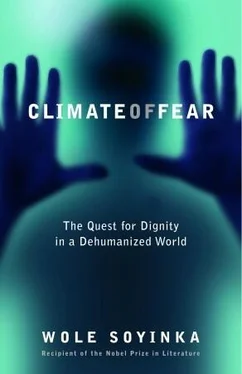However, a hard core of the message embedded in that emotive ferment may linger on, resulting in individual recalls, at various levels of consciousness, of the basic tenor of the collective experience, urging on the execution of its embedded message. The core of retention may be beatific, resulting in a resolve to improve the lot of a long-neglected neighbor, make restitution where some illegality has been committed, or an immoral advantage secured. It can lead to a grandiose vision for the betterment or salvation of mankind. The religious variety is prone to generating such an aftermath, a Moral Rearmament longing of one kind or another. On the other hand, alas, it may produce the very opposite, the destructive and apocalyptic.The ideological route is an equally mixed bag, but usually more disruptive, more contradictory, since it lays claim to rational processes yet acts with the dogmatism of pure revelation.
What I have referred to as rhetorical hysteria may therefore be safely considered the product of a one-way communication; that is, the monologue or public harangue. Dialogue, on the other hand, actually involves exchange, and the circumstances must be very abnormal indeed when it results in the hysterical condition. It is both convenient and relevant to personify, at this point, the difference between these two through the contrasting personalities of the late Ayatollah Khomeini, and others of like temper, and the current, embattled leader of Iran, President Khatami. We shall return to this most instructive pair toward the end.
It would also help, perhaps, if we advanced our exploration of the rhetorical theme through the terrain of light relief, if only to nudge the more self-assured nations, movements, and religions in the direction of a sense of proportion. We might reflect their certitudes through escapades that are often no more than self-indulgent gambits, which they would prefer to despise as simplistic mimicries of their own more advanced and elaborate, as well as better-structured and — packaged manifestos.What often develops to the level of rhetorical hysteria may begin as small pinpricks designed to annoy a complacent society and perhaps reinforce a group feeling of dissidence, but may grow into veritable monstrosities of absolute notions that run amok, consuming all within sight until they eventually consume themselves or are consumed by more rabid challengers. I shall share my favorite example, but not just yet. First, we should establish the sociopolitical background and context, just to situate ourselves in the general ambience of its times.
Many here will still recall that leftist phase of the sixties, labeled Trotskyite or Maoist, one that is now being superseded by other radical motions toward the transformation of man and society. It is a phase that is now receding into obscurity, thanks mostly to the collapse of communist ideology. I happen to believe that the humanistic foundation of the socialist ideal has not been thereby invalidated, but this belongs to another discourse entirely. In any case, the passion for a basis in ideological righteousness is still daily manifested in isolated anarchic acts against society, as well as in ideologically based wars around the globe. The period that I wish to recall was characterized by the exploits of the Red Brigade, based largely in Italy, Action Directe in France, the Baader-Meinhof in Germany, etc., with clones in Latin America and Japan, in addition to one or two isolated spots in Asia. Perhaps the most sensational single event of that period was the kidnapping and murder of the former Italian prime minister Aldo Moro. Kidnapping of businessmen or their relations for ransom was commonplace, nor can one easily forget the ruthless, cult-style executions in hidden mountain caves of Japan for alleged crimes of deviation from the pure strain of the revolutionary ideal. Not too surprisingly, other variants resulted in convoluted alliances between ideological and criminal impulses — drug trafficking allied to radical idealism in countries like Colombia.
The famous youth-inspired 1968 uprising in Paris that attempted to resurrect a commune modeled after the Paris Commune of the French revolutionary ferment was another notable manifestation of the passion for change, a severe testing of the status quo, and very French in temper, despite its continental alliances. Other names like Daniel “Danny the Red”, Cohn-Bendit, Regis Debray, and Angela Davis entered the lore of world revolutionary gladiators, satellites in orbit around the ultimate symbol of the times — Che Guevara. Depending on which arc of the class spectrum one occupied, and the methodology of action advocated and deployed, the overall movement evoked among the world population extreme degrees of admiration, revulsion — and fear. How wide would the movement spread, especially among youth? How deeply would it undermine the fabric of society?
This, then, was the setting for a far less sensational but widely spread offshoot of the same cast of mind — the junior partner, if you like — that had sprung up within the radical atmosphere of the sixties. It is the extract from the diffuse, nonlethal offshoot, a proliferating mantra, that I wish to identify as typifying the nature of rhetoric that, in varying degrees of flippancy and adolescent conviction, can graduate over time into an agenda for unreflective extremism. It builds up to a hysterical level that turns an otherwise rational section of humanity into active conduits for, at the very least, a mandatory suspension of disbelief. It is a phenomenon that reveals itself in its abandonment of skepticism. A new community is born, imbued with its own moral code — again, not one that is subjected to rigorous tests — that places itself outside existing social arrangements. A complacent society views it at first with a condescending amusement, later with trepidation.
How I came to observe this process firsthand was just as relevant to my observations. I was in self-imposed exile, a therapy I had embarked upon for another situation of lethal rhetorics that had sacrificed a million or two of Nigerian humanity under the rhythmic mantra: To keep the nation one is a task that must be done. Our civil war was being concluded in a mood of euphoria and, as I emerged from prison detention, I was not sure which form of hysteria grated more — the tone of nationalist jingoism that had surrounded me before I was locked up, one that made that war inevitable in the first place, or the barely suppressed triumphalist smugness into which I was thrust as I regained my freedom. Military success was equated with a divine vindication of the war.
On the other side, in the breakaway Biafran state, the same syndrome had more tragic results.Youths went into battle with nothing but wooden guns in their hands, captives of the same rhetoric that was drummed daily into their heads— No power on the African continent can subdue us. That belief had somehow translated into the mimic guns with which they charged the federal foe, as reported by a colleague who pronounced himself numbed by the experience. Was it any different, I wondered, from the self-submission of normally hardheaded men to the rhetorical powers of a Ugandan, Alice Lakwena, and her Holy Spirit Mobile Forces? Alice’s volunteers charged into hails of bullets, convinced that they were immune to their penetration, that the force of bullets was neutralized as a result of the inoculation that Alice had administered to them. After the capture of Alice in Tanzania, a university professor who had been part of her army was asked, in an interview, how it was possible for him, a man of presumed intellect, to have been persuaded of the supernatural powers of this woman, and for so long. He could proffer no answer, only that he supposed that they had all been under some spell. Fatalities, he said, had been rationalized away — such victims were only the weak in faith. This scenario has been sadly encountered in many more civil-war zones all over the continent, most especially among the child soldiers.
Читать дальше












